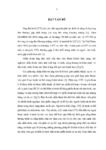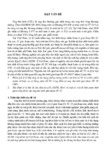
Please use this identifier to cite or link to this item:
http://dulieuso.hmu.edu.vn/handle/hmu/1965Full metadata record
| DC Field | Value | Language |
|---|---|---|
| dc.contributor.advisor | PGS.TS. Nguyễn Tuyết, Mai | vi |
| dc.contributor.author | Ngô Xuân, Quý | vi |
| dc.date.accessioned | 2021-11-14T13:42:28Z | - |
| dc.date.available | 2021-11-14T13:42:28Z | - |
| dc.identifier.uri | http://dulieuso.hmu.edu.vn//handle/hmu/1965 | - |
| dc.description.abstract | Những kết luận mới của luận án: . Q ua nghiên cứu 125 bệnh nhân được chẩn đoán là ung thư lưỡi phần di động giai đoạn III, IV (M0) được điều trị hoá chất bổ trợ trước bằng phác đồ TC, sau đó phẫu thuật và/ hoặc xạ trị tại Bệnh viện K từ tháng 1/2012 đến tháng 10/2018, chúng tôi rút ra một số kết quả như sau. Tỷ lệ đáp ứng và tác dụng không mong muốn của hoá trị bổ trợ trước phẫu thuật và/hoặc xạ trị bằng phác đồ TC trong điều trị ung thư lưỡi giai đoạn III- IV (M0): Sau 3 chu kỳ, tỷ lệ ứng hoàn toàn chiếm 14,4%; đáp ứng 1 phần chiếm 44%; bệnh giữ nguyên chiếm 36,8%; có 4,8% BN tiến triển sau 3 đợt. Hạ HST chủ yếu gặp ở độ 1 và độ 2; Không ghi nhận được trường hợp nào hạ tiểu cầu độ 3,4. Hạ BC hạt độ 4 đợt I,II,III tưong ứng là 22,4%; 26,4% và 25,6%. Nôn, buồn nôn gặp chủ yếu độ 1,2. Đau cơ, biến chứng thần kinh ngoại vi gặp chủ yếu độ 1,2.. Thời gian sống thêm toàn bộ trung bình 36,48 ± 2,23 tháng. Tỷ lệ sống thêm toàn bộ 5 năm đạt 24,1%. Thời gian sống thêm trung bình của nhóm bệnh nhân được điều trị phẫu thuật sau hoá chất tân bổ trợ cao hơn của nhóm được điều trị xạ trị kết hợp hoá chất sau hoá chất tân bổ trợ (42,32 tháng so với 30,03 tháng). Tỷ lệ bộc lộ EGFR dương tính là 36,8%. Có mối tương quan giữa tình trạng bộc lộ EGFR và giai đoạn T, giai đoạn bệnh. di căn hạch, giai đoạn bệnh, độ mô học, tình trạng đáp ứng. Giai đoạn T, tình trạng di căn hạch, giai đoạn bệnh, tình trạng đáp ứng, tình trạng bộc lộ EGFR là những yếu tố ảnh hưởng tới thời gian sống thêm.. | vi |
| dc.description.abstract | New contributions of the thesis:. Through a study on 125 tongue-cancer patients at stages III and IV (M0) who received chemotherapies before the TC regimen, average age of getting the disease was 52.5, the most common age group was from 41 to 60 years old, accounting for 76%, and the male/female ratio was 3.6/1. After 3 cycles, rate of complete response accounted for 14.4%; rate of partial response was 44%; rate of non-remission was 36.8%; and 4.8% of participants became progressed after 3 courses. Most participants had grades 1 and 2 thrombocytopenia. There was no grade 3 or 4 thrombocytopenia case recorded. Rates of participants having grade 3 leukopenia on course I, II and III were 28%, 24.8%, and 23.2% respectively. Vomiting and nausea mainly saw at grades 1 and 2. Myalgia and peripheral neuropathy complications also occurred at grades 1 and 2.. Averaged overall survival (OS) was 36.48 ± 2.23 months. 5-year survival rate reached 24.1%. OS of post-neoadjuvant-chemotherapy surgical group was higher than that of post-neoadjuvant-chemotherapy radiotherapy combined with chemotherapy group (42.32 versus 30.03 months). The positive EGFR expression rate was 36.8%. There were correlations between EGFR expression and stage T, disease’s stage. Stage T, nodal metastasis status, disease’s stage, response status, EGFR expression status were factors that affect to overall survival.. | vi |
| dc.language.iso | vi | vi |
| dc.subject | 62720149 | vi |
| dc.subject | Ung thư | vi |
| dc.title | Nghiên cứu kết quả hóa trị bổ trợ trước phác đồ TC và tỷ lệ bộc lộ một số dấu ấn liên quan đến ung thư lưỡi giai đoạn III- IV (M0) | vi |
| dc.type | Thesis | vi |
| Appears in Collections: | Luận án (nghiên cứu sinh) | |
Files in This Item:
| File | Description | Size | Format | |
|---|---|---|---|---|
| 484_TVLA NGOXUANQUY.pdf Restricted Access | 2.48 MB | Adobe PDF |  Sign in to read | |
| 484_TTLA NgoXuanQuy.pdf Restricted Access | 1.21 MB | Adobe PDF |  Sign in to read |
Items in DSpace are protected by copyright, with all rights reserved, unless otherwise indicated.